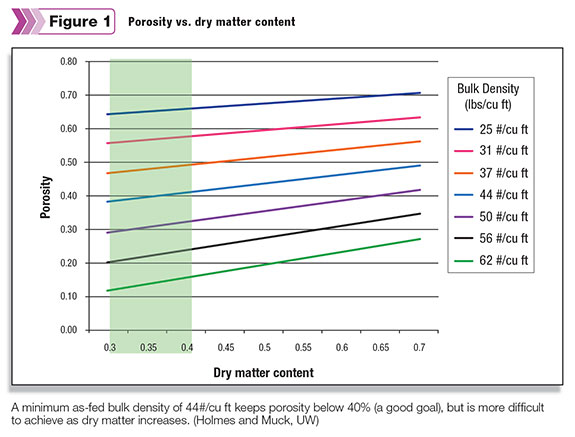Global population is increasing exponentially. There will be billions of new mouths to feed. And the world’s natural resources, including soil and water, just won’t be able to keep up with this new demand.
Brian Ritter, a global sales management adviser with Elanco, recently told a group of Vita Plus staff that we’re already using 125 percent of our natural resources to supply the world’s current needs for food.
By 2050, we’ll need 70 percent more food to feed the expected population. And according to Ritter, most of that increase will come from the use of current or new technologies.
To say that we can save the planet by packing and covering is a little over the top, but change the word “food” in the above comments to “feed” and your opportunity to think globally and act locally presents itself right at the farm level.
Most producers have a limited land base and supply of water, so we’d better make sure we preserve as much of our harvested crops as possible. Unfortunately, that’s not always happening.
Keith Bolsen, professor emeritus from Kansas State University, tells us that shrink loss in silage is too high and happens too often. He estimates the cost of shrink loss on silage in the U.S. at $1.3 billion, but it could be reduced to $600 million by taking advantage of current technologies and practices.
Packing density critical
In the February 1, 2013 issue of Progressive Dairyman , Bolsen’s article entitled “Packing density: Putting dollars to density” showed in a case study how going from one packing tractor to two improved dry matter density from 11.3 pounds per cubic foot to 16 pounds per cubic foot.
Bolsen likes to point out that, theoretically, you could improve dry matter density by reducing the delivery rate of silage to the bunker – but in practice that just doesn’t happen.
A major consideration in silage density and increased delivery rate continues to be increased chopper capacity. Additional considerations include the size and location of fields.
These factors influence delivery rate, which in turn influences how much tractor capacity is needed. Tractor capacity can be manipulated either by increasing the number or weight of the tractors or packing equipment.
Unfortunately, in bunker situations space may limit the number of tractors that can access the forage. In some of these cases, simultaneously filling and packing two bunkers at the same time will help alleviate some of these issues.
When looking at silage density numbers on bunkers and piles, it is critical to remember the reason we want high densities, and that is to reduce oxygen. Oxygen is our enemy in silage fermentation. We pack to minimize the porosity (air pockets) in silages.
Similar to the holes in a sponge, these pockets can be filled with either silage gases produced during fermentation, oxygen or water. If the forage contains more moisture, more of these pores will be filled with water.
Unfortunately, in summarizing haylage and corn silage moisture, we find many farms have been putting up drier forage over the last several years. Focusing on drier forage is often part of an effort to avoid the dreaded clostridial haylage or to maximize starch in corn silage.
While these are admirable goals, as forage gets drier, more porosity or air spaces exist, particularly if forage is cut longer. Increased porosity, often coupled with large feeding faces on bunkers and piles, can defeat our ultimate goal: reducing oxygen infiltration.
In fact, once we open these bunkers or piles and silage gases escape, oxygen can and will diffuse into these air pockets, defeating our primary goal.

Brian Holmes and Richard Muck, University of Wisconsin researchers, are encouraging the evaluation of density on the basis of as-fed weight per cubic foot of silage.
They believe this measurement better reflects the concept of porosity and have determined that 44 pounds of as-fed density equates to 40 percent porosity or less.
In addition, to achieve the best possible results from packing, be sure to lay silage in thin layers (6 to 8 inches max) and keep the finished surface as smooth as possible in order to cover closely.
Slope piles and bunkers adequately to drain water and snowmelt away from the forage.
Covering and sealing: Other important components
Last fall, John Brantsen, a Vita Plus dairy specialist in northwest Iowa, conducted a survey of snaplage bunkers and did an exceptional job of illustrating the value of the feed just a couple feet under the plastic.
Brantsen used snaplage as an example and a value of $164 per ton as-fed. Contained in the top 2 feet of an 80-foot x 200-foot bunker, there are 590 tons of feed, according to Brantsen’s calculations. At $164 per ton, that’s $96,760 worth of feed … just in the top 2 feet.
At 30 percent DM loss, that’s 177 tons of feed worth $29,028 evaporated into thin air through respiration. Even at 20 percent loss, that’s 118 tons, or $19,352, simply gone. It’s clear that dairy and beef producers need to spend the time and dollars it takes to cover silage properly.
No matter how much effort is put into packing to a high density, it is impossible to obtain as high a density on the top and sides of bunkers and piles. Thus, covering technique becomes critical to maintaining an airtight seal.
We liken it to when your nutrition consultant comes out to pull a forage sample. They put the forage into a plastic bag, carefully squeeze out excess air and then effectively close the seal. Think of sealing your pile or bunker as one big plastic bag.
Once we have squeezed out the excess air (packed), our goal becomes developing an effective outer seal to keep excess oxygen out of the forage mass.
One of the most critical steps to an effective seal is to use enough weight around the perimeter of the bunker or pile. A common error we see is not enough plastic left around the bottom edges of piles.
We like to see a minimum of 2 to 3 feet of plastic covered with a heavy material. Limestone screenings, gravel, filled gravel bags, heavy whole tires or even rubber cow mats can work well.
For bunker walls, covering walls with plastic to prevent water infiltration can save a lot of forage quality and dry matter. When covering bunker walls, don’t forget to protect the top rough edges of the bunker walls with drain tile, used rubber material or even carpet.
There is nothing more discouraging than going through the effort of covering the walls only to have small stress holes develop in the plastic that let water in anyway.
Once the perimeter is secured, the rest of the pile or bunker cover needs to be uniformly weighted with enough heavy weight to prevent billowing and exterior damage from causing excessive spoilage.
The amount of weight will vary depending on the size of the storage unit and the location. Piles exposed to high winds may need to lay down two to three layers of split tires or tie them in a web fashion to prevent billowing or complete loss of the silage cover.
Once the pile is opened, the feeding face becomes one of these “perimeter” areas that require heavy weight to keep the leading edge of plastic from allowing air infiltration. Gravel bags form a heavy singular line and work exceptionally well to hold plastic in place.
With the development and use of plastics that limit oxygen exposure, visual spoilage on bunkers and piles can be eliminated with proper technique. We like the thin, flexible clear plastic that molds itself to imperfections on the top of the silage.
Don’t pull this plastic too tight. Allow it to fill in gaps and make sure the plastic extends to the vulnerable edges. In many cases, the two layers offer an additional layer of protection from critters or birds.
Since true oxygen-limiting plastics use resins which are expensive, don’t buy the cheapest plastic claiming to have high oxygen-barrier properties. Ask to see independent test results and university data supporting their claims.
Finally, speaking of wildlife, don’t go through all the hard work of covering and sealing your pile and then ignore it for the rest of the year. A regular schedule should be established to inspect piles for damage.
Holes should be sealed with tape designed for sealing bunker or bag plastic. If seams have pulled loose, make sure they are correctly overlapped so rain and snow do not infiltrate the pile. PD
Urness is a national forage specialist with Vita Plus Corp.

Chris Wacek-Driver
Forage Program Manager and Dairy Nutritionist
Vita Plus Corp.






